What is UPN?
What is UPN (Universal Process Notation)? In the world of Process Mapping, UPN is a method of mapping that is easy to understand for the widest audience. Recommended by Salesforce, who call it a ‘simple, engaging diagramming notation’, it is designed to work for anyone and not just the technical experts. Read on to discover why UPN could be the solution to stronger collaboration, stakeholder buy-in and engagement in process management for your organisation.
UPN was first documented as a specification at Nimbus Partners which later became part of TIBCO Software. One of Skore’s founders, Craig J Willis, wrote the early versions of the specification. Today there are several software products, including Skore, that support Universal Process Notation.
In this article we will answer the following questions for you;
- What is UPN ?
- How does it work?
- Where did it come from?
- What is it for?
- Why do so many businesses choose it over other approaches?
So exactly what is UPN?
Universal Process Notation uses symbols to describe business processes in a universal way. It is the simplest format and is quick to learn and straightforward to read. Business process notations, such as UPN and BPMN, are standardised methods of mapping business processes in a visual form. We map business processes to understand how any work is done in an organisation. We use diagrams to show how the work and data flows through an organisation. It’s a great way to understand complicated processes because we can look at them visually. UPN saves you time, engages your team and stakeholders and creates a long lasting legacy that everyone can collaborate on.
Want to learn more about business process mapping? – check out our comprehensive guide here >>
Where did UPN come from?
Universal Process Notation is based on IDEF0 system modelling with some simplifications.
How does it work?
Activities
UPN is a very clear language that really focuses on how people describe and think about work. It uses 1 shape to represent an activity in a process and natural language to describe the type of activity.
Let’s look at an example – here, if the activity is to ‘send a notification’ it is described as:
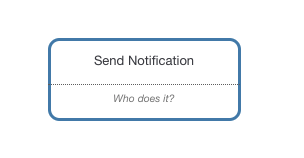
An activity (What Box) captured in Skore
Outputs
Every activity in UPN is followed by an output. The output tells us why the activity is done, or when it’s finished. UPN is designed to be used in a conversational setting, like an interview or workshop. As such, the output is a powerful tool to help individuals think more deeply about the process. So here we can describe the output very simply as:
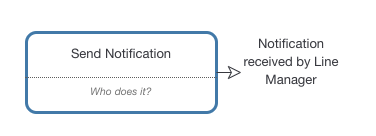
Activity and Output (What and Why box) in Skore
UPN is rare in insisting on an output in this way. For other types of notations this means analysis is often lost during the actual mapping process. Analysts frequently have to carry out additional analysis later on, which takes up more time.
Roles and Resources
The final key building block of any UPN process is the Role, or Resource, required to do the activity. This is the Who, the person that does the activity, or the system required. We can very easily add this to our activity box.
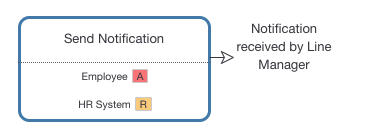
Activity showing a role and a system with RACI
Want to know more about roles and responsibilities using RACI? Check out our RACI overview here >>
Sub-Processes, Details and Drill Downs
One of the unique aspects of UPN is that it has multiple levels within a single process map. UPN recommends that process diagrams are easy to read and fit on a computer screen. For processes with lots of activities this can be hard but UPN makes it easy by using this approach.
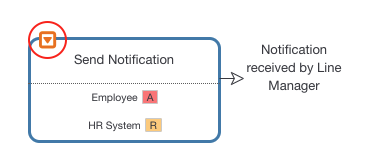
The ‘detail view’ button is on the top left of the what box and created with a single click
Activities are grouped together and then summarised in a single activity with a subprocess, or detailed view, underneath. There are no limits to the amount of levels you create, it’s all about making it easy to read. It’s a bit like Google Maps where you can zoom into the detailed street view for a given town or city.
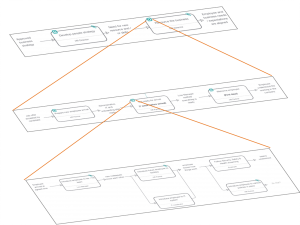
Detail views allow you to drill down into sub-processes
Attachments
Finally, other important information can be easily associated with steps in a process through attachments. These could be detailed descriptions, additional instructions or links to other places. Ultimately it’s about making sure that all the information is just a click away from anyone following the process.
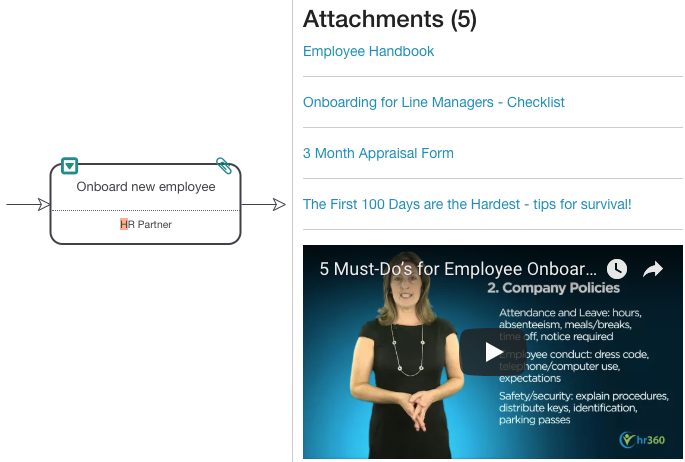
A variety of attachment types are accessible through the paperclip icon
Want to try Skore for yourself? Talk to one of our experts today >>
The Benefits of UPN
Universal Process Notation can be used in most situations where we require process maps. It is particularly powerful where you need to involve large numbers, or a diverse range of people.
For example, if cross functional teams have to collaborate on a process, UPN provides a simple common language for all the teams working together.
Because the approach here is so simple it is easy enough to use to map processes live into software during a workshop. This saves a huge amount of time for both the analyst and the participants. No one needs to wait for notes to be rewritten and shuffled around, it can be done at the pace of the conversation in the room. At the end of the workshop the processes can be shared directly rather than waiting to be transcribed into another software product. Plus if you have key stakeholders in the room there is no reason why you can’t sign off on your process straightaway, no waiting around for weeks for people to come back to you.
In addition, the system based style of UPN means that everyone in the workshop can structure their thoughts in a more natural way. As a result we get more analysis taking place in the workshop rather than after. The participants and stakeholders can quickly develop a better understanding of the problems and solutions in the process. This means they get clarity early on and are more likely to buy-in and engage.
Finally, the simplicity of the notation makes it easy enough to read so you don’t need to train someone to understand it. Therefore an organisation isn’t dependant on just one person having the skills to manage process mapping and saves times. The straightforward format means the processes can then be used for many different types of documentation such as standards, training and user manuals.
The Most Common Uses of UPN
With many of the benefits around Universal Process Notation being about simplicity there are a huge number of uses.
Software Implementation / Upgrades
Software implementation projects are one of the most common types of initiative where UPN is first used in an organisation. These types of projects need to quickly understand how things work today, how they will work with the new system and identify the gaps.
This requires working closely with the people that perform the process and ensuring they are clear about the changes. UPN is perfect for achieving this by quickly engaging with a wide range of stakeholders and getting them bought into the change. The attachments function means it is really easy to add all kinds of useful information on to the process maps – including legacy software systems or useful information.
Training / User Manuals
Most businesses start process mapping in order to diagnose and solve a particular problem. Once that time has been invested in creating these documents they are valuable assets providing they are kept up-to-date.
With UPN it’s common for these process maps to then belong to the teams, or process owners, that execute the process. Those teams regularly review and update their own processes without the need for specialists, unless there is a specific process improvement to be made. There is no reason why your processes shouldn’t become ‘living’ documents that can be used by everyone in an organisation to help them do their jobs well.
Audits and Compliance
Once UPN processes have been established, in a library, they are incredibly useful for demonstrating compliance with various rules and regulations. The processes are simple enough to avoid ambiguity and can be shared easily with an auditor and whoever else needs to be informed.
Organisational Design and Business Transformation
Like software implementation projects, Org Design and Business Transformation are popular initiatives that adopt UPN as the approach to process discovery and mapping. These programmes often have an even larger focus on the human side of change management which makes UPN the perfect tool.
Key Things to Remember about UPN
At the time of writing this article Universal Process Notation has been in use in organisations of all sizes for over 20 years. UPN has been used to underpin Business Process Management and Improvement programmes in global organisations in Oil & Gas, Pharmaceutical, Fast Moving Consumer Goods, Retail and Manufacturing.
And it’s not just the largest organisations that benefit from this approach. Thousands of small and medium sized businesses have used UPN to scale up and improve customer experience.
If you’re planning any of the initiatives above then keep these things in mind when deciding whether UPN is the right approach to use:
- Do you have to involve large numbers of people? UPN helps you quickly get buy-in and alignment among large numbers of people due to the simple and easy to learn nature of the approach.
- Do you have to engage different audiences? If you have to work with both technical and non-technical audiences UPN provides a simple common language that makes cross discipline communication easier.
- Are these processes going to be an ongoing asset? UPN is the perfect approach for building easy to use process maps that can be referenced and updated into the future.
Are you planning to use UPN in your organisation? Talk to us to learn more about the fastest and easiest UPN software available today.
Get In Touch To Find Out More Here